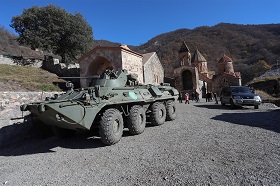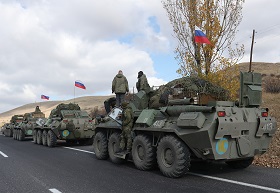Like Asgard, Armenia is not a place, it is a people. Apart from the three million Armenians living within their nation-state, the notion also includes some seven or eight million that live beyond its borders, yet do, in some manner, feel that they belong to the “Armenian world.”
The latest events in Armenia are certainly not a Ragnarok yet, nor a trump of doom or the harbinger of a collapsing Armenian state. But amid the recent military defeat aggravated by a calcifying divide in the Armenian society coupled with the ongoing COVID-19 pandemic and an economic recession, the situation in the country is extremely precarious. It is no longer merely a question of whether Nikol Pashinyan will stay in power, or what the relations between the civil authorities and the military leadership will look like, or in what terms the status of Nagorno-Karabakh will be ultimately defined. The question now concerns the future of the Armenian statehood, it being more serious than ever before in the 30 years of Armenia’s post-Soviet history.
Is there a viable alternative to the liberal project in Armenia?
From the traditional Realpolitik perspective, Armenia is doomed. The country, with a population of about three million and a territory smaller than the Moscow Region, has no significant oil and gas reserves like the neighbouring Azerbaijan, nor does it have fertile lands like Georgia, Armenia’s another neighbours. The geopolitical situation is dispiriting for Armenia: the country does not even share a common border with Russia, its ally, and is surrounded by an openly hostile alliance of Turkey and Azerbaijan as well as two rather ‘backhanded’ partners, Iran and Georgia. Going back to the “pre-Pashinyan” era would mean Armenia having to get used to the role of a humble petitioner camping on the doorsteps of the faraway Kremlin offices year in and year out.
The liberal democratic paradigm is Armenia’s best chance for a future. The first, most urgent and most important task is not to merely reform the political system but to design a new national idea that would lead society away from the pernicious temptations of endless irredentism. Obsessive ideas of continuing the confrontation with Azerbaijan and taking back the lands lost last year must become a thing of the past.
Armenia’s main comparative advantage has always been its diaspora, something unique its neighbours do not have. Radically new development priorities are required to transform Armenia from the eternal “relation in need” into a country of opportunity. A country that lives not only by its past, but also by its future. Public discussions should focus on the continued search for such development priorities, rather than on some chimeric scenarios of “taking Artsakh back.”
The relatively recent (2017) Hollywood blockbuster Thor: Ragnarok has a memorable scene of the heavenly kingdom of Asgard collapsing. A happenstance witness to and participant in Ragnarok, the last battle between the good and the evil, King of Asgard and God Thor, finds himself unable to avert this disaster. Suddenly, when everything seems hopelessly lost, he has a revelation: “Asgard’s not a place, it’s a people.” And he sets about evacuating his people from the collapsing city.
At this point, Thor recasts himself from an aloof autocratic deity into a dynamic liberal leader. Certainly, he is no neoliberal postmodernist of the early 21st century, but rather a classical liberal of the late 18th century. He realizes that the main value of his kingdom is not the land, the state, property or mystical artifacts, but its people. Men and women. Old and young. All of them together and each of them individually. If the people remain, a new Asgard could be built, even at the other rim of the universe.
The latest events in Armenia are certainly not a Ragnarok yet, nor a trump of doom or the harbinger of a collapsing Armenian state. But amid the recent military defeat aggravated by a calcifying divide in the Armenian society coupled with the ongoing COVID-19 pandemic and an economic recession, the situation in the country is extremely precarious. It is no longer merely a question of whether Nikol Pashinyan will stay in power, or what the relations between the civil authorities and the military leadership will look like, or in what terms the status of Nagorno-Karabakh will be ultimately defined. The question now concerns the future of the Armenian statehood, it being more serious than ever before in the 30 years of Armenia’s post-Soviet history.
The situation is further exacerbated by the fact that the prospects of Armenia embarking on a path of liberal democracy have lost much of their lustre over the last couple of years. Many hopes had been pinned on Nikol Pashinyan’s tenure, but it brought Armenia neither the promised prosperity nor stability. Pessimism, social apathy and cynicism, as well as disillusionment with democratic institutions and the path of democratic development, are therefore on the rise. It is no accident that calls for transferring power to a technical “government of national accord” are increasingly heard in Yerevan. Some even go on to suggest it would be a good idea to bring the military into power for a while.
Yet, is there a viable alternative to the liberal project in Armenia? From the traditional Realpolitik perspective, Armenia is doomed. The country, with a population of about three million and a territory smaller than the Moscow Region, has no significant oil and gas reserves like the neighbouring Azerbaijan, nor does it have fertile lands like Georgia, Armenia’s another neighbours. The geopolitical situation is dispiriting for Armenia: the country does not even share a common border with Russia, its ally, and is surrounded by an openly hostile alliance of Turkey and Azerbaijan as well as two rather ‘backhanded’ partners, Iran and Georgia. Going back to the “pre-Pashinyan” era would mean Armenia having to get used to the role of a humble petitioner camping on the doorsteps of the faraway Kremlin offices year in and year out.
The liberal democratic paradigm is Armenia’s best chance for a future. The first, most urgent and most important task is not to merely reform the political system but to design a new national idea that would lead society away from the pernicious temptations of endless irredentism. Obsessive ideas of continuing the confrontation with Azerbaijan and taking back the lands lost last year must become a thing of the past.
Like Asgard, Armenia is not a place, it is a people. Apart from the three million Armenians living within their nation-state, the notion also includes some seven or eight million that live beyond its borders, yet do, in some manner, feel that they belong to the “Armenian world.”
Armenia’s main comparative advantage has always been its diaspora, something unique its neighbours do not have. Until now, the diaspora has treated Armenia much in the same way that successful young urbanites tend to treat their aging parents who live out the rest of their days in a ramshackle village somewhere far away: Money transfers (sometimes quite generous), trips home to soak up the nostalgia, traditional “kebab and cognac” get-togethers, declarative support for the “Armenian cause”—little else ties the diaspora with its historical homeland of global “Armenian-ness.”
If Armenia reverts to the “pre-Pashinyan” era, even this level of support will be very hard to sustain. And transforming the country into an attractive investment hub for the diaspora’s substantial funds will be nigh on impossible. Radically new development priorities are required to transform Armenia from the eternal “relation in need” into a country of opportunity. A country that lives not only by its past, but also by its future. Public discussions should focus on the continued search for such development priorities, rather than on some chimeric scenarios of “taking Artsakh back.”
Today, Armenia’s technocrats speak of the prospects of developing the country as a transportation and logistics corridor for the South Caucasus. However, here the country will face tough competition in the form of alternative transit projects, including those that involve the trans-Caspian route. There are plans to transform Armenia into a giant Caucasus mining farm, but Georgia has already beaten it to the punch. Armenia could still become a regional leader in developing the “green energy” sector, especially since there are many areas that abound in sun and wind and are short on rain and snow, areas with high mountains and unpopulated plateaus.
In any case, Armenia is now facing the task of reviving its scientific and technological potential, dramatically improving the quality of its “human capital” and warding off the emerging provincialism. All this requires the public spirit to be radically “demilitarized,” while preserving democratic institutions and procedures as a sine qua non.
The liberal project for Armenia by no means demands that Yerevan turn away from Moscow and pin all its hopes on the West. However, Russia–Armenia relations should be built as relations between two equal partners rather than on the basis of patron-client ties. Being a member of the Eurasian Economic Union (EAEU) and the Collective Security Treaty Organization (CSTO), Armenia may just become the principal venue for Russia to promote its multilateral developmental projects in the Caucasus, involving Georgia and Azerbaijan.
Given its unique geopolitical situation, Armenia could also claim the role of a bridge between Russia and Europe, between the Eurasian Economic Union and the European Union.
Armenia’s potential role in long-term “Greater Caucasus” integration projects is no less important. Given the region’s ethnic and religious diversity, lasting peace and development in the Caucasus are only possible if it is gradually and steadily transformed from a set of states into a community of regions (which, historically, the Caucasus has nearly always been). This single ecosystem could also include Nagorno-Karabakh, Abkhazia, South Ossetia and other historically shaped areas with their unique identities.
Such models do exist in today’s world. For example, the Swiss Confederation, where individual cantons are not united into a Swiss Germany, a Swiss France and a Swiss Italy, while enjoying considerable autonomy within a single ecosystem. Clearly, conservative groups among the national elites will be against such a “Caucasus of the regions,” being mostly interested in exerting as much control as possible over their states, both recognized and unrecognized. They are in no way interested in delegating even some of their powers to the regional level. Therefore, a stable and harmonious ecosystem in the Caucasus will hardly emerge in the near future. The Swiss Confederation did take a few centuries to emerge, though.
First published in the Russia in Global Affairs journal.






